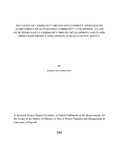| dc.description.abstract | The dependence on donors for investments on economic and social development work has been on
the increase in developing countries due to the constraints in national budgets as a result of
unsustainable increasing public expenditure. This has seen calls for effectiveness, sustainability and
accountability to the public programmes and projects funded by donors. As a result, Community
Driven Development (CDD) approach to community economic and social projects and programmes
has grown rapidly in many countries as an effective mechanisms for channelling development to
the public. Donor funded projects and programmes grounded on CDD approaches aim at improving
the livelihoods of the communities sustainably through direct participation of the communities.
However, until recently, there has been little rigorous evidence on the efficacy of this social
development approach. Thus, given the large amounts of funds committed to CDD projects it
becomes vital to determine whether this approach is viable, sustainable and worth supporting since
it is expected that the projects will influence the sustainable livelihoods of the communities through
enhancing their food security, health, social and economic status, gender equity, education status,
access to water and shelter among others. This research therefore seeks to assess the influence of
community driven development projects on the achievement of sustainable community livelihoods
in the case of the Western Kenya Community Driven Development and Flood Mitigation Project
(WKCDD/FMP) in Busia County. The studysought to answer the questions; to what extent does (i)
prioritized community investments/projects, (ii) gender mainstreaming, (iii) capacity building and
(iv) flood mitigation as CDD initiatives influence the achievement of sustainable community
livelihoods? The research adopted a descriptive survey design which enabled the researcher to
collect data from the large target population while correlating the variables to deduce how the states
of affairs are at the time of the research. The research targeted the beneficiaries of the
WKCDD/FMP project in Busia county targeting 200 households drawn by the Slovin’s formula.
The research utilized well-structured questionnaires for the households in collecting quantitative
data; key informant interview guides and focus group guides for collecting qualitative data.
Secondary data was collected from review of related studies, project reports and other related
literature. Quantitative data was coded, entered, validated and analysed using the Statistical
Package for Social Sciences (SPSS) version 18.0 through descriptive and inferential statistics and
correlation of variables. Qualitative data on the other hand was categorized by themes for analysis
and the categorization verified by independent experts. The Findings indicate that CDD projects in
the County which were prioritized by the community had contributed to the improvement in
welfare and living standards of the households and were rated by 74% of the respondents as very
successful in improving their livelihoods. On gender mainstreaming, 70.5% of the women
interviewed were members of community development groups and 96.8% had actively participated
in meetings for decision making while 87.1% had participate in trainings for capacity building.
Capacity building had improved the skills and knowledge levels of the communities in sustaining
their livelihood activities with 98% of the respondents indicating they were indeed utilizing the
gained skills and knowledge. Flood management had achieved its objective as only 23.7% of the
households had been affected by floods and 46.65% confirmed they had increased crop production
as there had been no crop loss by floods. In conclusion, it is evident that the CDD approach has
significantly contributed to food security, economic security, gender equality, education and access
to shelter as indicators of sustainable livelihoods as well as strengthening community cohesion,
governance, accountability and ownership structures. The study recommends continued capacity
building, gender mainstreaming efforts for the project; policy alignment to guide CDD approaches,
and development of framework for rural governance structures for government and development
partners; and further qualitative research on principles of CDD approach, documentation of
successful CDD approaches and comparative study of the CDD approach and centralized approach
to community development | en_US |

